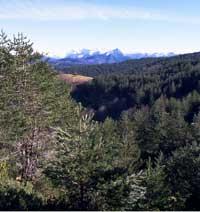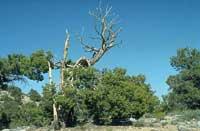"Recovery" of American forests.
2000/05/07 Imaz Amiano, Eneko - Elhuyar Zientziaren Komunikazioa
flames are large in the cypress forests of Utah, located on the slopes of the Wyoming Bighorn. Until a few years ago to preserve protected spaces, among other things, all fires were extinguished in order to maintain their ecological and landscape value. However, the managers of the Tensleep reserve have used fire in recent years to cope with cypresses that proliferated in abundant meadows and to clear a pondera pine forest that accumulated dead and sick wood. They have burned 283 hectares and say that if they have not burned them before, lightning could cause a terrible fire.

However, in Bighorn not only are possible fires considered as a risk of excessive forest growth. Cypresses and pines are replacing the plants that bloomed to this land more than a century ago, both European and before the arrival of their livestock. Controlled fire is only one of the attempts of local managers to return to the state of protected ecosystems.
In addition to soft ones, numerous ecologists consider that the generation of fires and other interventions such as selective cuts are an essential strategy for the recovery of "sick" ecosystems. The goal is to return them to "balance before settling or settling."
The
need to reduce the risk of large forest fires in the United States has also contributed to this new position: in January, the forest service stated that about 17 million hectares of western forests presented a "high level of risk of natural fires." And this is a consequence of the enormous effort made over several years to extinguish natural fires. So last year federal agencies deliberately set fire to 931,000 hectares, more than double the annual average of the previous decade.

But as these types of forest protection projects have been put in place, there has been a debate among environmentalists about the need for fires and short controlled timber. The key is to know what the forest looked like in the places before settling. In fact, in the territories exploited by the human being, many times the species that grow fast increase in a disinterested way. In the Bighorn basin, for example, paleoecological people have seen: The rapid expansion of Utah cypress and pondero pine is probably due to climate change over the past 5,000 years, although livestock and fires have also contributed. "Many middle managers and ecologists tend to consider that the 20th century changes are not all natural, and that doesn't have to be so." Paleoecologists have studied the plant remains of the fossilized excrements of the mouse Packrat and the nests made with the feces, and after studying hundreds of excrements, they have concluded that in the temperate of about 4,500 years ago the cypress Utah took refuge in the dry habitats of the canyons of Wyoming and Montana, further north. The coldest atmosphere of the next 2,000 years reached many of these territories and cypress remained forming small patches of Wyoming. In the next 2,000 years, time again took the tendency to temper and apparently recovered the territory lost by cypress. Therefore, cypress has increased and decreased its distribution throughout history.
In recent
times, however, the factors that have accelerated the advance of cypress can be livestock, fire cleaning and the end of the small ice age around 1850. "If the advance is a consequence of grazing or fire cleaning, you can try to avoid it." "But if it is a natural invasion derived from climate change, how or to what can the ecosystem itself be restored?" Taking this into account, the Tensleep protection zone has used less fire against Utah cypress, since, in short, before using harsh methods to reduce the risk of fire or return the environment to a prepopulation situation, the historical ecology of forests should be taken into account.

In
other areas of protection the debate is similar: it is about returning to the situation prior to the European repopulation, but what was that situation? If you have seen that nature is dynamic, at what point do you want to return? Or should I let him go alone?
Although no one questions the need to reduce the risk of fire, there are scientists who question prepopulation models. From meteorological data and tree rings, the population of pondera pine in the Coconino protection zone was reinforced in the early 1800s and then again in the early 1900s. "Taking a certain recovery date will not take into account the possible subsequent reactivation period," he adds. It would be more correct to move towards an uncontrolled and totally changing forest than to do so according to the ideals we have. This would be enough to reduce the risk of fire and allow nature to become its own. From this point of view, the prepopulation model would only be an initial point. In short, the objective would be none other than to put the ecosystem in a field of play in which the conditions of nature were the same, and then nature follow its path."

Deepening further, the discussion would be whether the recovery of forests to the pre-population situation is a legitimate goal, considering that Native Americans were distorting the environment long before the arrival of Europeans. "The settlements have been for 10,000 to 20,000 years until today." "The forest and the people who lived in it formed an indivisible whole that evolved simultaneously for thousands of years." However, some experts claim that the influence of Native Americans was low. "People, in general, tend to say that from any point of view prior to massification human intervention is perceived. On the contrary, lightning fires were the main architects of the landscape before the European repopulation arrived." Therefore, the most appropriate strategy would be to use controlled and clear tree fires to return to the situation that will manage the small natural fires that have occurred frequently. Or why not let nature itself ignite these small fires? would be one of the answers.
Although
scientists discuss what and to what extent they can use North American forests to maintain a healthy pre-population state, each restoration project should be based in part on local ecological history. The key is “how and where to do recovery and what use of the past”. In any case, the opinion of many is that scientists and policy makers must act quickly and reach consensus on this matter before they can speak for an ecosystem in a precarious situation.
There and here the same thing?
In the
main article we mentioned the debate on forest management in the United States. We are probably struck by the fact that after seeing and hearing numerous fire campaigns in our environment, one of the forms of forest management can be the use of fire (intentional or spontaneous ignition, abandoned).

It
should be noted, however, that in both cases the situation is totally different. On the one hand, in its "natural or natural forests" the extension has nothing to do with the extension of the "natural or natural forests" here. When it comes to burning a piece of controlled forest, of course, it is a larger part than almost any native forest.
On the
other hand, in the Atlantic area of the Basque Country, most of the forests are pine plantations and their objective is not at all the conservation of nature, but the economic, so it cannot be allowed to burn! Therefore, if
this debate arose, we should adapt it to the situation here.
Published in the supplement Natura de Gara
...

Gai honi buruzko eduki gehiago
Elhuyarrek garatutako teknologia






